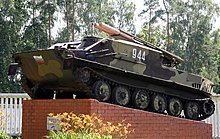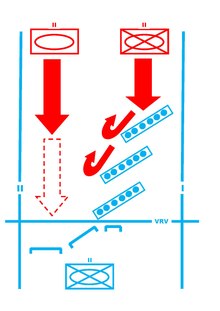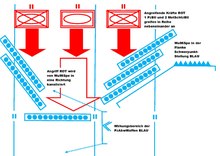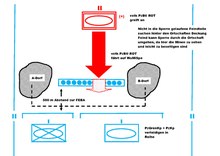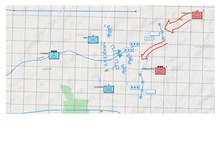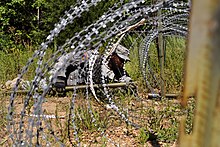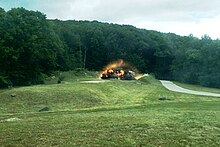Battle for bans

The struggle for barriers by combat troops (security and surveillance by tanks , tank grenadiers , hunters , mot riflemen ) or artillery , mine clearance by pioneers ( tank pioneers with the appropriate large equipment), and the fight with barriers are important aspects of a modern tank war . In the Cold War played anti-tank mines on both sides of the defense, and on the part of the attacker a major role. While the defender endeavored to slow down a tank advance through a network of anti-tank mine barriers (usually throwing mine barriers) in the area and to channel it in a desired direction, the attacker on the other hand endeavored to bypass these mines or to get them as quickly as possible vacate. These mine barriers could be laying (VerlegerMiSpe), straightening (RichtMiSpe) and throwing mine barriers (WurfMiSpe) according to the pioneers' blocking plan. In addition, false mine barriers could be set up in order to prevent the enemy from taking possession of this area, to change his intention, to take the attack swing and to provoke the early use of his clearance equipment. Mine barriers were usually kindly marked for their own troops. The battle with barriers plays a role especially in the types of operations delay battle and defense .
Duties of the pioneer group
The main tasks of the pioneer group include:
- Inhibiting the enemy's movements
- Creation of locks
- Preparation and triggering of military paralysis
- Encourage the movement of your own troops
- Overcoming barriers
- Overcoming terrain obstacles
- Creation of passages through terrain obstacles
- Carrying out special camouflage and deception measures
Duties of pioneer reconnaissance teams
Pioneer reconnaissance teams are tasked with:
- report enemy barriers according to type, location and extent
- Determination of the need for forces, resources and time windows for opening the enemy barrier
- Exploring workarounds
- Troop leaders of the combat troops propose the possibilities
Definition of locks
The following types are counted among the barriers created by the engineer force:
- Mine barriers: anti-tank and anti-rifle mines
- Construction barriers: wire barriers, tree barriers, barricades etc.
- Blast barriers: funnel barriers, bridge demolitions and targeted destruction of other traffic facilities and structures
Inhibition of tank movements
Anti-tank mine traps
This topic includes the creation and overcoming of barriers. Barriers strengthen the area and they influence the conduct of operations on both sides. Tank pioneers have the option of mine barriers by creating
- Mine path with mine clearance manager
- Mine lane through mine clearance equipment
to open.
Mine path
By the wandering of from Minenräumleitern ( s. MICLIC (mine-clearing line charge)) allows the engineer to hit a 60 centimeter-wide mine path enemy minefields. This can also be done manually by mine clearance teams from the ordnance clearance forces of the pioneers.
Mine lane
Mine lanes are created by mine clearance equipment. The Bundeswehr mainly used the Keiler mine clearance vehicle for this purpose.
Operational principles tank pioneers (NATO) in creating barriers
The interaction of fire, locks and movements is one of the main features of defense. Both locks and lock-free areas are shown on the location maps or the lock plan.
The NATO troupe and the Bundeswehr had because of their defensive doctrine their focus rather in the creation of minefields and less in the rooms. Mine barriers had their main task in securing flanks, certain objects, key spaces, strengthening areas of terrain (area reinforced by pioneers) and intercepting attacks. Laying mine barriers (PzAbwVMi) with a limited operating time were laid openly or concealed by mine- laying machines , trucks or manually and were able to block certain sections of the site for a longer period of time. Mine barriers could be combined with mine barriers, the latter concentrating on narrow spaces, gap paths, increasing the clearance resistance through mechanical mine clearance or delimiting areas.
Mine barriers played the largest role in NATO's defense planning. The WuMiSpe could be fired by the rocket artillery with multiple rocket launchers LARS , MARS , the Army Aviation or Air Force Bell UH-1D with launcher battery, fighter-bomber Tornado using multi-purpose weapon 1 (MW-1) or from 1986 by the pioneer troops with the Skorpion mine throwing system. Mine traps and their operating time were requested by the troop leader to prevent an enemy tank penetration. Mine barriers can be planned in advance, but in practice they are set up in the course of the battle depending on the location or the target.
Mine barriers were set up by pioneers and then handed over to the combat troops for monitoring / security. The pioneers hand over fully charged blast barriers in the ready-to-ignite state based on an explosion command.
By using mine throwers, the defender was able to create mine barriers within 15 minutes in critical and endangered sections of the site, which would have previously taken significantly more time with other laying methods. A single mine thrower had eight times the performance of a tank engineer company with conventional laying methods. There was the consideration of a so-called "blocking reserve" in order to be able to lock off endangered burglary sections at short notice. The use of locking devices is based on the requirements of the combat troop leader's plan of operations.
The assessment of the high numerical superiority of the enemy artillery fire had led to barriers being placed relatively close (approx. 400 meters) in front of the own positions to be defended during exercises. This was based on the idea that the enemy would not hit the barrier until he had already moved his fire cylinder / barrage deep into the defense area. Without the protection of its own artillery, there would have been a high probability of intense fire fighting between battle tanks and armored personnel carriers. When creating the operation plan, special attention must also be paid to the closure planning (closure plan pioneers) in order not to use valuable blocking capacity on “useless” sections of the site. An ideal barrier was within the main combat range of one's own weapons. The closure planning must be adapted to the terrain in particular. In front of the field positions, mixed and pure containment mine barriers from anti-rifle mines should be used for immediate protection in front of or in the flanks. The general assumption was that the line of descent (LA) was about 400 meters from defenders' positions. Combat and armored personnel carriers for surveillance and fire protection followed the assault run by the dismounted Mot-Schützen. The general aim of mine barriers was to narrow the enemy's room for maneuver and to make one's own fire more effective. The main purpose of the barriers in the Combined Arms Combat was to direct enemy forces into certain rooms in which they could have been smashed by concentrated fire in the focus of attack, the use of PAH ( BO 105 and A-10 ) or by counter-attacks.
Operational principles Tank pioneers (Warsaw Pact) in overcoming and clearing barriers
The pioneer work to break through an enemy defense was regularly practiced on the major maneuvers of the Warsaw Pact. Detected or cleared barriers are marked, reported and subsequent forces are warned accordingly. If cleared mine barriers could not be cleared, they were bypassed by the attacking combat troops. For the Warsaw Pact, the combat troop regulation "attack" applied: "Mine barriers are ... bypassed or overcome after creating paths and alleys" . The Warsaw Pact had the following large-scale military equipment for mechanically pyrotechnic mine clearance and forcible opening of anti-tank minefields.
- Mine clearance vehicle MTK-2 ( BTR50U ) with "attached" mine clearance ladder
- Mine clearance vehicle UR-77 ( MT-LBu ) with "attached" mine clearance ladder (hose load with rocket drive). The UR77 mine clearance tank worked with an explosive or hose charge with rocket propulsion. The Polish People's Army used a WLWD system as an explosive device to create a mine alley about five meters wide.
These armored vehicles could also be used under NBC protection and fire a line tow rocket on a six meter wide ladder, which was detonated over the enemy minefield and could create an 80 to 120 meter long mine lane. UR-77 and MTK-2 were considered the most effective means of evacuation of the Warsaw Pact. Four to eight mine clearance vehicles were in use per Mot rifle or tank division.
BMR3M, KMT-5 (nine KMT-5 per PzRgt / three KMT-5 per MotSchtzRgt), KMT-6, KMT-7 and KMT-10 mine scooters were used for mine lanes. These could only clear over the width of the roller (chain left and right), but not against anti-tank mines that detonated under the vehicle hull. They were not effective against mines such as DM31 anti-tank mine (inductive shaped charge forming ), DM21 anti-tank mine (explosive) with articulated fuse, AT2 anti-tank missile mine , AT1 anti-tank mine, as well as the “Flat Flat Mine” (MIFF), which ignited directly under the clearing tank.
The land forces of the NVA were aware of this problem and it was recommended to pull a stretched load behind the clearing armor with a mine roller. Barriers were generally guarded by the defending troops and so it was to be assumed that cleared clearing tanks were preferred by the defending anti-tank defense and fought mainly with PALR (anti-tank guided missiles) MILAN , HOT and TOW in order to maintain the barrier as long as possible. The Bundeswehr countered the enemy mine clearance tanks with DM12 anti-tank directional mines to strengthen the edges of the minefield or to strengthen the clearance resistance. The disadvantage of main battle tanks with KTM5 or KTM6 attachments was that they were heavy, could only work at slow speeds and thus offered an easy target for enemy anti-tank defense. The fight against clearance tanks has a similarly high priority as the fight against command and flak tanks.
Should a tank company RED encounter a prepared anti-tank mine barrier, it was planned that the company commander of the tank company would request the responsible ASB (department for ensuring movement) or the SRA (lock clearing department) to force an opening.
On the pioneering tasks in the attack, v. a. of the 1st season, included:
- Pioneer education and exploration
- Encourage the movement of attacking troops by overcoming barriers, demolitions and natural obstacles, and by building and maintaining roads and paths
- Creating barriers to protect the movements of your own attacking troops
- camouflage
An ASB typically consisted of:
- Pioneer reconnaissance u. Lock clearing party
- Road construction team
- Bridge construction team
- Leadership u. Security squad
The troop was usually reinforced from one or two pioneer groups (15 to 20 men strong), an ABC reconnaissance group and mostly a mot rifle group.
The equipment included:
- DIM road mine detector
- ABC reconnaissance vehicle BRDM Rkh
- Mine clearance device KMT-4 or KMT-5
- Engineer tank IMR or battle tank with clearing blade BTU
- MTU-20 bridge-laying tank
- Explosives and mine clearance cord
Possible processes in battle
Foremost parts of an attack group and the subordinate ASB hit a mine barrier. Initially, the KMT-4 mine clearance device is used as an attachment, with which all PzKp were equipped as standard. The speed when clearing is slowed down. The KMT-4 battle tanks driving into the minefield must be secured by other weapon systems. Fire protection and fog are used here. The cleared strips are roughly the width of armored tracks, so that they can only be driven on by following vehicles with the same track or track width. In the case of an operation at night, this would have been a highly dangerous action. For a combat troop battalion of the 1st Squadron, around six to eight lanes have to be cleared, ideally one lane for each attacking armored train. After overcoming the mine lock from the 1st squadron, the pioneers have to widen the alley to six to eight meters in order to be able to follow up on artillery, air defense, anti-tank destroyers and supplies.
- Attack through enemy mine barriers
" When attacking, the armored combat troops are particularly at risk from mine barriers ." (Instructions for leadership and operations. AnwFE 700/108) If mine barriers cannot be bypassed, they must be opened by the combat forces or pioneers. To do this, a mine lane of a defined width and length must be cut for a certain period of time.
Pioneers clear up, mark and open enemy barriers. The company of the combat troops reports a cleared enemy lock for inclusion in the lock plan. The enemy fire must be switched off so that the clearance operation can be carried out.
Lage PzGrenBtl 161 am 020100Z OCT 86 PzGrenBrig 16 defends on the VRV along the ELK against enemy attacking from the east, who managed to break into the north of HORNBEK with his second DivStaffel (MotSchtzRgt BMP) late in the evening of 01 OCT. PzGrenBtl 161 fell back to the position north-west of WOLTERSDORF and inflicted heavy losses on the enemy. PzGrenBtl 163 has so far successfully fended off all enemy attacks on the VRV. SpähZg 16 with subordinate PzJgZg secures the left flank of PzGrenBtl 161 from the northern edge of GÜSTER, making use of mine barriers. The vstk reconnaissance platoon is directly led by the PzBrig 16. PzBtl 164 - BrigRes - has the order to attack the enemy who has broken in on 020030Z between GRAMBEK and GÖTTIN, to quickly take and defend the canal area between GÜSTER and ON THE HEIDE, which is close to the banks. Artillery focus of fire from the start of the attack at PzGrenBtl 161.
BtlKdr has ordered in VfgR: attack in the wedge, vstk PzKp ahead. Approaching two marching streets, and drove ahead with his mobile command post to Fhr SpähZg 16 to the northern edge of GÜSTER. From him and from the brigade he receives information which gives the following picture: - Detected before height xx 3 GMZ when creating mine barriers, 1 GMZ shot down, south of HORNBEK mine barriers created by MotSchtz. - 15 km to the east ELK marching movements of armored forces in the west. Our own air force flies from 011900Z BAI (Battle Air Interdiction) against these forces and against the SIEBENEICHEN war bridge.
Comment on the situation: - enemy forces in the break-in section fought down to 40% - dry autumn weather with clear visibility. New moon. Space between BÜCHEN and BREITENFELDE dry pastureland, wooded areas and small towns - the GMZ mine-laying device carries 200 anti-tank mines. Laying speed 10 km / h
Radio conversation from Kdr PzGrenBtl 161 Bwgl BefStelle to ZgFhr PzPi 220830Z clock: “ Block both sides HORNBEK with MiW against Pz ROT. Action time 3 hours. Instruction at the east exit HORNBEK by OrdOffz. Rest of PzPiZg 2. Kp subordinated. " MdL directly from Kdr PzGrenBtl 161 Bwgl BefStelle to OrdOffz 220832Z clock: " Instruct MiWe. After laying lock. Handover to PzGrp. MiW then follow PzPiZg. Notification of a mine barrier to Btl and left neighbors. "
Radio conversation from Kdr PzGrenBtl 161 Bwgl BefStelle to ZgFhr PzPi 220830Z clock: “ Block both sides HORNBEK with MiW against Pz ROT. Action time 3 hours. Instruction at the east exit HORNBEK by OrdOffz. Rest of PzPiZg 2. Kp subordinated. " MdL directly from Kdr PzGrenBtl 161 Bwgl BefStelle to OrdOffz 220832Z clock: " Instruct MiWe. After laying lock. Handover to PzGrp. MiW then follow PzPiZg. Notification of a mine barrier to Btl and left neighbors. "
- Transfer and takeover of locks
- Preliminary investigation and measurement of the lock by PiTr
- Engineer troops receive an order from the troop leader combat troops to lay a mine barrier
- Liaison between the pioneer troops and the combat troops at the barrier
- Report to BtlGefStd "Mine barrier set up at plan indicator XY"
- In radio traffic communication of lock no / deck name d. Lock and status triggered / closed
- After the mine barrier has been set up, instruction by pioneers
- Handover / takeover of the blocking documents to combat troops
- Completion report to troop leader combat troops "Block taken at plan indicator XY"
- Behavior of the combat troops according to Demolition order
- Counterattack through locks
- Enemy situation: 8th Guards Army ROT continued the advance through MIDDLE FRANCES, is largely worn out by delayed battles and is gathering for further tasks in the ANSBACH area.
- Own location: PzBrig 29 "Südbaden-Hohenzollern" is to carry out a counterattack against parts of the 8th Guard Army at the interface of the 20th GdPzDiv and 20th GdMotSchtzDiv near ROTHENBURG / TAUBER.
For this purpose, attack formation BLUE (PzBrig 29) carries out the following division of forces:
| Unit | Cover name | Insinuation | Levies |
|---|---|---|---|
| PzBtl 294 | FIST | 2./PzGrenBtl 292 four PzPiGrp (TPz) |
|
| PzGrenBtl 292 | FALCON | PzGrenBtl 292 | |
| FArtBtl 295 | HAIL | ||
| PzPiKp 290 | ELECTOR | four PzPiGrp (TPz) | |
| PzJgKp 290 | COIN NAIL |
Execution: reinforced PzBtl 294 leads attack in Breitkeil, four PzPiGrp (TPz Fuchs), III. Zg / 2. / PzGrenBtl 292 at the top for clearing barriers. Preliminary order for attack: where are which barriers to be expected, what to do when the enemy appears, is the enemy superior and which process lines did he cross?
- 01 1700 Z OCT 86 A Marder AFV fails due to running into a mine barrier.
- Option 1 fire attack RED: Enemy opens fire from BK AFV (25mm) and MBT (125mm). Decision Kdr 2./PzGrenBtl 292: “Fog and fire. All parts of the chain march backwards! Order to FArtBtl 295 "Hold down" cover fire with five groups of explosives and three groups of fog. "
- Option 2 reply fire: AFV and MBT take position, at the same time fire response, dismounting and deployment of Rifle squads PzGren, at the same time KpChef 2. / - if not already carried out, requests barrage. Trigger barrels on fireplaces in accordance with the Artillery Fire Plan: DONAU, RHEIN and NECKAR as a fire roller.
KpChef 2./- instructs pioneers by radio: "FAUST to all mine locks / wire locks from their own position over open space at Kusselgruppe 200m to the left of the intersection of streets L1022 and AN6 in front of SCHNEPFENDORF, enemy at BRUNDORF, take position, return fire, hold enemy down / separation HAGEL smoke screen for 15 minutes at QUERWALD immediately / separation KURFÜRST (PzPi) lock under fuse PzGren open on my sign. Separation, FALKE (PzGren) monitors the action of the pioneers, on recognized enemy fire free / separation, CARGNAGEL (PzJg) secures left and right flanks and fends off counter attacks. After opening the barrier, FAUST and FALKE break through the barrier and throw the enemy / separation, SARGNAGEL monitors the action. The End."
The principle is that the Führer Pioneers is in the immediate vicinity of the Führer fighting force. The execution of the individual orders depends on the location of the enlightened enemy forces, enemy strength, terrain, weather conditions and other variables. Radio reports from combat troops to pioneers: "KURFÜRST here FAUST mine barrier / wire barrier from his own position over open space at Kusselgruppe 200m to the left of the intersection of road L1022 / AN6. Establishing a connection with FALKE-2. Open wire lock. Report as finished to me. End. " Combat discussion PiGrp before dismounting from TPz Fuchs: " Men listen, mine barrier / wire barrier in front of their own position over open space at Kusselgruppe 200m left of the intersection L1022 / AN6. We open the wire lock, establish a connection with FALKE-2. It goes with: Pioneers 1, 2, 3, 4th Pioneer 3 with three blasting tubes. Pioneer 2 with four 4 SKZ (pilot light ignition) and Pioneer 1 with two smoke pots. Deputy, Pioneer 4, monitor implementation and take over the job in the event of a failure. Sit down! "
- Procedure when clearing a wire barrier: PzPi approach the barrier with dismounted PzGren. Rolling over action with cover fire, AFV Marder and opening of the barrier by PzPi using a detonation pipe or stretched cargo.
- Procedure when clearing a mine barrier: Request a mine clearance tank Keiler , which is so close to the combat troops that it is ready for action for about five to 10 minutes. Mine clearance tank Keiler is promptly instructed in its order by PiFhr or Stellv via gap paths to the lock.
Inhibition of infantry movements
Infantry attacks can be slowed down and hindered in the long term through the use of wire barriers, tripwire barriers , S-roller barriers , Spanish riders , wiring, S-roller barriers in underground systems, Flanders fences and area wire barriers . The use of improvised explosive devices ( s. "Booby Traps" ) are prohibited on the Western side.
Wire locks
Wire barriers are used to strengthen your own positions or to protect objects against attacking infantry. However, if the depth is sufficient, they can also bring wheeled and tracked vehicles to a standstill.
Tripwire barrier
Up to a certain height of the ground cover, tripwire barriers can be used, which surprise dismounted attacking forces, hinder their movement and break the attack swing. Tripwire barriers approx. 10 to 15 centimeters above the ground are secured by sharpened stakes and their cut surface is camouflaged. Efficient protection against the unnoticed approach of enemy infantrymen (mot riflemen) can thus be achieved with relatively simple expenditure of material and time. Wire barriers should be outside the enemy's hand grenade range.
S-roller lock
Multi-layered and multi-layer S-roller barriers, which are fastened with pegs, are suitable in confusing bottlenecks, passages to other barriers and in local battles in stairwells and hallways in order to hinder the action of dismounted forces in the long term. The blocking effect can be increased by the application of explosive charges (concealed charges, hand grenades or explosives), which are triggered when the attacking troops attempt to overcome or tear down the wire barrier. Flares work in the event of an alarm when the dismounted enemy tries to overcome the wire barrier in the dark. Furthermore, the locking effect is strongest when several different types of wire locks made of barbed wire or S-rollers act one after the other in the depth.
Spanish horsemen
Spanish riders are barriers made of crosses, bars and wire barriers that are commonly used on roads and paths to block the passage of vehicles.
wiring
The purpose of wiring is to reinforce your own positions in wooded and puddled areas or on the outskirts. Similar to the tripwire, the ribbon wire can be camouflaged by the vegetation in the ground. The ribbon wire can be wrapped around tree trunks at a low height and thus protects against unnoticed approach to your own position.
Flanders fence
Flanders fences are surface wire barriers that were already used in the trench warfare of the First World War , especially in the material battles on the Western Front. They consist of stakes and barbed wire stretched out like a net. Flanders fences are deeply staggered in zigzag form or overlapping very efficiently against enemy vehicles and dismounted mot-shooters. Three Flanders fences built one behind the other have a relatively high barrier effect.
Overcoming wire barriers
Combat troops traditionally try to overcome wire barriers, especially S-roller barriers, by the cooperation of three men. Two soldiers bend the wire into a position so that a third soldier, lying on his back, can cut it with wire cutters . This often happens under fire protection and in the dark or in poor visibility. Another possibility is to use it with combat and explosive devices, preferably with stretched charges or detonators, to knock an alley into the wire barrier to allow attacking infantry to move further.
Although the combat troops practiced the manual way of opening wire barriers with wire barriers, one of the orders of the pioneers, or the demolition squad, was to use explosive tubes / DM51 or DM61 (metal tube filled with explosives), stretched charges (100 g TNT) or the mine clearance divers 80 . The detonator acts as a prefabricated stretched load. They are ignited with a pilot light or electric ignition. For wide alleys of a wire barrier, several explosive tubes are often required next to each other.
Mine types (WW II, Cold War)
Bundeswehr and NVA
- AT-1 drop mine from Dynamit Nobel
- AT-2 mine made by Dynamit Nobel
- M43 stick mine (WW II)
- DM-12 PARM , anti-tank directional mine, in service from 1988
- DM-11 A / P, amagnetic / metalless anti-rifle mine / anti-personnel mine with pressure release
- DM-11 A / T, almost metalless anti-tank mine with pressure release
- Glass mine 43 , anti-personnel mine made of glass (WK II)
- DM-21 anti-tank laying mine 1 generation with grass-like flocking (with pressure / and / or pull tinder or articulated fuse)
- DM-31 , jumping mine. Rifle defense installation mine of the German Armed Forces was eliminated due to the Ottawa Convention between 1995 and the end of 1998.
- DM-31 (licensed by FFV 028) anti-tank mine 2nd generation with inductive ignition system
- PPM-2, anti-personnel mine, "infantry mine" with piezoelectric pressure detonator, for training purposes of the border troops (NVA)
- Riegelmine 43 , anti-tank mine (WW II)
- Riegelmine 44, anti-tank mine (WW II)
- S mine , spring mine (WW II)
- Rifle mine 42 , anti-personnel mine made of wood (WK II)
- Tellermine 29 , anti-tank mine (WW II)
- Tellermine 35 , anti-tank mine (WW II)
- Tellermine 35 (steel) , anti-tank mine (WW II)
- Tellermine 42 , anti-tank mine (WW II)
- Tellermine 43 , anti-tank mine (WW II)
- Pot mine , anti-tank mine (WW II)
US Army
- M2 anti-personnel mine (WK II)
- M3 anti-personnel mine (WK II)
- M14 anti-personnel mine, introduced in the 1950s
- M16 anti-personnel jumping mine, primary anti-personnel mine of the US armed forces of the 1950s
- M18 Claymore anti-personnel-directed fragmentation charge, developed during the Korean War
- M93 Hornet modern anti-tank mine
Soviet Army and Warsaw Pact
- MON mines: MON-50 , MON-90, MON-100 and MON-200, anti-personnel mines with directional effect, similar to the American Claymore
- OSM mines : "Frog mines", OZM-3, OZM-4 and OZM-72 anti-personnel mines, jumping mines with splinter effect
- PFM-1 anti-personnel mine, "butterfly mine" / "Green Parrot"
- PMD-6 rectangular anti-personnel mine made of wood
- PMN mines : PMN-1 and PMN-2, anti-personnel explosive mines
- POM-1 and POM-2 anti-personnel mine for remote mining
- PGMDM anti- tank mine for remote mining, also known as PTM-1
- PTM-3 anti- tank mine with magneto
- TM-35 to TM-89 anti-tank mines
See also
literature
- Ulf Bergelt: Department for Ensuring Movement (ASB) and Movable Blocking Department (BSA) , in Truppenpraxis 10/1981 P. 792 ff. Darmstadt, Wehr und Wissen Verlagsgesellschaft.
- Dietrich Biewald: Pioneers in the 8th Motorized Rifle Division of the National People's Army of the GDR. EDITION digital. 2016. ISBN 978-3956-55588-6 .
- Sigurd Boysen: Mine warfare - its limits and possibilities Part I , in Truppenpraxis 7/1981 P. 547 ff. Darmstadt, Wehr und Wissen Verlagsgesellschaft.
- Sigurd Boysen: Mine warfare - His limits and possibilities Part II , in Truppenpraxis 8/1981 P. 617 ff. Darmstadt, Wehr und Wissen Verlagsgesellschaft.
- Jürgen Degner and Ulrich Saft: Firepower and blocking effect - The strength of the defense , in Truppenpraxis 11/1984 P. 836 ff. Darmstadt, Wehr und Wissen Verlagsgesellschaft.
- Dieter Gerner: Structure, equipment and use of the Soviet pioneer company . In Wehrausbildung 4/1984 p. 136 ff.
- Gunter Freytag and Bernd Kaltenbach: Struggle with locks , in Truppenpraxis 1/1991, S. 54 - 60. Darmstadt, Wehr und Wissen Verlagsgesellschaft.
- Gunter Freytag: Panzer Grenadiers and Pioneers in Defense , in Truppenpraxis 3/1988 P. 308 ff. Darmstadt, Wehr und Wissen Verlagsgesellschaft.
- Bundeswehr: HDv 100/100 leadership in battle . Ed .: Bundeswehr.
- Bundeswehr: ZDv 3/701 lock and blow up . Ed .: Bundeswehr.
- Bundeswehr: ZDv 285/100 blocking and blowing up the pioneers . Ed .: Bundeswehr.
- Bundeswehr: ZDv 286/110 ordnance of the pioneer service . Ed .: Bundeswehr.
Web links
- Pioneer mission with mine clearance manager (film document)
- M58 MICLIC Clears Obstacle with Rocket Projected Explosive Line Charge - Use of a mine clearance ladder
- MICLIC Explosions • M58 Mine Clearing Line Charge. MICLIC detonation in the mine warfare of Afghanistan
Notes and individual references
- ↑ Bundeswehr: Artillery in Action Part 2 2/2. Retrieved July 18, 2020 .
- ↑ Panavia Tornado IDS MW 1 (multipurpose weapon 1, multipurpose weapon dispenser). Retrieved July 18, 2020 .
- ↑ Bundeswwhr: Classix: The new mine thrower of the army (1988) - Bundeswehr. Retrieved July 18, 2020 .
- ↑ Handover by the pioneers and takeover by the combat troops in accordance with StANAG 2989 based on a blocking message
- ↑ Bundeswehr training folder tactical (forces RED)
- ↑ KMT-5 mine clearance device
- ↑ KMT-6 mine clearance device
- ↑ as multipurpose weapon 1 (MW-1) shot cluster ammunition containers from anti-tank mines with double hollow charge; equipped with a magnetic field sensor, among other things
- ↑ DV service instruction A 052/1/002 blocking service. Council of Ministers of the GDR Ministry of National Defense. 1987
- ↑ Explosives tube
- ↑ an OMG - operational maneuver group were z. B. 2 ASB available
- ↑ The ASB generally served to maintain the security of movement on the divisional marching roads with bridge-laying tanks, BAT road construction machines, etc. As a pioneer division, they were deployed relatively far up front in the division's marching band
- ↑ Unfortunately, the km / h information is not shown in the source here
- ↑ with modified units and locations from "Attack via enemy mine barriers." OTL Peter Meier x / 198x troop practice. Darmstadt, Wehr und Wissen publishing company
- ↑ Rainer Oestmann: I order this ...! Manual for military leaders . Management process up to division level. Walhalla publishing house. 2012. p. 1003ff. ISBN 978-380-296023-9 .
- ↑ Blocking documents: Blocking plan with blocking overview, blasting plan, mine blocking certificate and mine report
- ↑ On-board cannon
- ↑ Detonator fuse
- ↑ prohibited on the UN Arms Convention of April 18, 1997, i.e. Ottawa Convention, which came into force on March 1, 1999
- ↑ Pioneers magazine of the pioneers and the Federation of German Pioneers issue 19 / June 2019
- ↑ Pioneers' weapons
- ↑ also term for mortar ammunition
- ↑ also term for mortar ammunition
Attention: The sorting key "clearing of anti-tank mine traps" overwrites the previously used key "fight for barriers".




